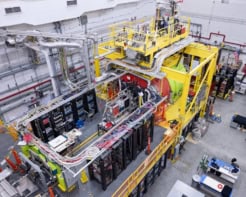
Physicists at the University of Texas have proposed a new type of fusion reactor that could destroy the most biologically hazardous nuclear waste. It would consist of a spherical tokamak containing a deuterium-tritium plasma, which would produce streams of neutrons that would be fired into the waste held in a “blanket” around the reactor. If built, the reactor could be operational in 15–20 years’ time and could even be used to generate electricity.
High-level nuclear waste contains not only uranium and plutonium but also other “transuranic” elements that are heavier than uranium and are the principal source of longer-lived radiation. Most such waste is put into stainless-steel flasks and stored in vaults, although it is possible to reprocess spent fuel and separate uranium and plutonium from the fission products. Some countries, like the US and Finland, are even planning to store unprocessed spent fuel for hundreds of years in costly underground repositories.
The new reactor, proposed by Mike Kotschenreuther, Prashant Valanju, Swadesh Mahajan and Erich Schneider would destroy the transuranic waste in a two-step process both involving the process of “transmutation”. The idea of transmutation has been around for some time and involves converting radioactive material, with a half-life on a geological timescale, into something with a much shorter half-life. Waste would still need to be stored, but its long-term hazard would be reduced.
However, existing transmutation methods, which are based on fission alone, cannot deal with transuranic elements. What the Texas team is proposing is to first attack the waste by placing it in a standard nuclear plant such as a light water reactor (LWR), which would destroy almost 75% of the transuranic waste by transmutation. The rest — non-fissile transuranic elements such as plutonium-242, americium-243 and curium-246 that cannot be destroyed by LWRs because the flux of neutrons is not high enough — would be destroyed by neutrons from the new reactor.
Kotschenreuther and colleagues’ proposed Compact Fusion Neutron Source (CFNS) is a version of the Mega Amp Spherical Tokamak (MAST) reactor at the UK Atomic Energy Authority in the UK and the National Spherical Torus Experiment (NSTX) at Princeton University in the US. It would generate neutrons by fusing deuterium and tritium nuclei but the magnetic field would be about 7 T — much higher than in MAST or NSTX — to increase the fusion pressure and so create a high enough fusion flux. Transuranic waste would be destroyed by loading it around the CFNS’s core. The CFNS would also contain a new kind of divertor, which remove the heat from the sides of the reactor.
The researchers say that their reactor could also be used to generate power as the transuranic waste burns, with about 90% being potentially sold to the grid and the rest used to keep the fusion process going. The researchers say that only one such machine would be needed to destroy the transuranic waste from 15 LWRs. “Realistically, if funding is available, the CFNS could be ready in 10–20 years,” says Swadesh, who thinks that it could cost a tenth of the €10bn being used to build the ITER fusion experiment in France.
One big problem with the technique is that the reactor would have to operate continuously. Currently, MAST and NSTX operate fusion for only 10 s, with only the KSTAR tokamak in South Korea operating for 1000 s. “The idea is attractive,” says David Ireland, a nuclear physicist from the University of Glasgow in the UK. “But there are some technical issues that would first need to be overcome such as if it is possible to maintain the plasma for long durations.”



